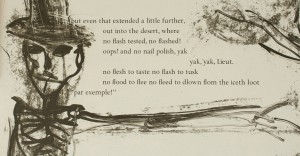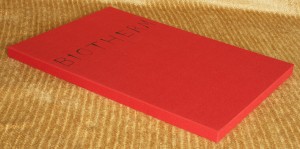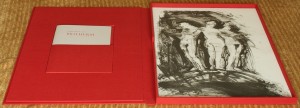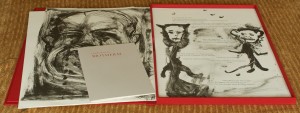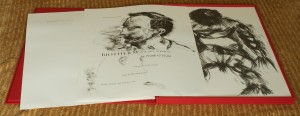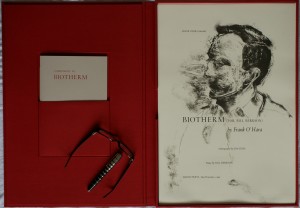 “Ut pictura poesis,” Horace wrote in the first century BC. “As is painting so is poetry.”
“Ut pictura poesis,” Horace wrote in the first century BC. “As is painting so is poetry.”
In his Poetry Foundation blog post “Poets and Painters”, Martin Earl writes “Painters and poets have been wed from the beginning. Language itself has pictorial roots. …Poets are attracted to the symbolic and pictographic traces of their own language in painting. For poets, painting is full of atavistic vocabularies. Painters, on the other hand, have always looked to poets to articulate what we might call their sublime backwardness.”
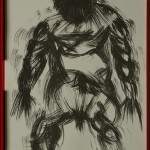 Frank O’Hara was part of the “New York
Frank O’Hara was part of the “New York 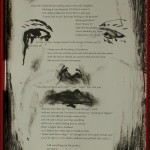 School” of poets, a title borrowed from the painters in New York city whose circles Frank frequented. Painters were his friends and art was a big part of his life. He worked at various jobs at the Museum of Modern Art, wrote regular art criticism, and was the curator of several exhibitions of painters of the Abstract Expressionist movement.
School” of poets, a title borrowed from the painters in New York city whose circles Frank frequented. Painters were his friends and art was a big part of his life. He worked at various jobs at the Museum of Modern Art, wrote regular art criticism, and was the curator of several exhibitions of painters of the Abstract Expressionist movement.
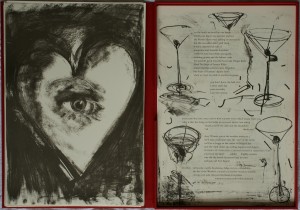 If he was here to see it, I think the Arion Press edition would be especially pleasing to this “poet among painters”. O’Hara took deliberate care in the spaces, indents, and line lengths for the poem, and the generous page size of the AP edition allows these to be printed as intended and gives Dine space to meld his art into a poem that resonated with him from the first time he read it. In the Publisher’s Note, Andrew Hoyem writes that “The poem signified for Dine a literary equivalent to his own disjunctive impulses in visual art” and goes on to state that
If he was here to see it, I think the Arion Press edition would be especially pleasing to this “poet among painters”. O’Hara took deliberate care in the spaces, indents, and line lengths for the poem, and the generous page size of the AP edition allows these to be printed as intended and gives Dine space to meld his art into a poem that resonated with him from the first time he read it. In the Publisher’s Note, Andrew Hoyem writes that “The poem signified for Dine a literary equivalent to his own disjunctive impulses in visual art” and goes on to state that
“Dine’s work elevates this publication to a true livre d’artiste: Here is an artist inspired by a work of literature, paying homage to it and to the writer with a visual interpretation and interpenetration.”
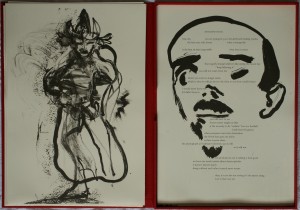 The sheer size of the pages, with text unencumbered by a constrained page, and the images Dine drew into and around the text, created a powerful reading experience as I read through the poem. Poetry by nature speaks in metaphor and allusion and I have to say that I was reminded of that prose master of allusion, James Joyce. This is not a bad thing for me, as I enjoy the work of unraveling his works, especially if I have a skeleton key or some annotations to help me along. And lo and behold, Bill Berkson has provided a glossary to help with some of the more obscure references, quotations, and allusions in the poem.
The sheer size of the pages, with text unencumbered by a constrained page, and the images Dine drew into and around the text, created a powerful reading experience as I read through the poem. Poetry by nature speaks in metaphor and allusion and I have to say that I was reminded of that prose master of allusion, James Joyce. This is not a bad thing for me, as I enjoy the work of unraveling his works, especially if I have a skeleton key or some annotations to help me along. And lo and behold, Bill Berkson has provided a glossary to help with some of the more obscure references, quotations, and allusions in the poem.
Berkson, to whom the poem is dedicated, also contributed the essay “Air and Such” to be included with the AP edition. He says,
It [Biotherm] portrays the relationship of two very close 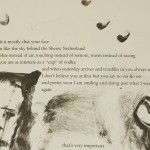 friends in their ways of speaking together. To some degree, any two friends talk with one another as neither would with anyone else. This is a function of what Frank O’Hara called “the appropriate sense of space”—the fluctuating space that two people feel and invent between themselves.
friends in their ways of speaking together. To some degree, any two friends talk with one another as neither would with anyone else. This is a function of what Frank O’Hara called “the appropriate sense of space”—the fluctuating space that two people feel and invent between themselves.
Those who venture to read Biotherm have the honor of being invited into this space that formed between the two poets.
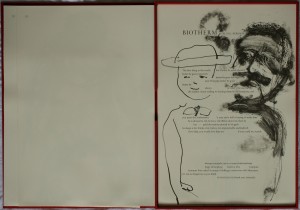 As I’ve mentioned a couple of times, Biotherm is huge and its impact is commensurate with that physical size! The unbound sheets are 22 by 15 inches. The paper is English mouldmade T. H. Saunders Waterford. I’m not sure I’ve run across this particular paper before but 23 years after printing, it still smells divine when you open up the portfolio box. Being unbound sheets actually made the reading even more enjoyable as one could hold a sheet at a time or simply flip them over within the box. If sheets of this size were bound it would limit how the book could be read. All in all, I’d have to say this is one of the gems in the crown of the Arion Press.
As I’ve mentioned a couple of times, Biotherm is huge and its impact is commensurate with that physical size! The unbound sheets are 22 by 15 inches. The paper is English mouldmade T. H. Saunders Waterford. I’m not sure I’ve run across this particular paper before but 23 years after printing, it still smells divine when you open up the portfolio box. Being unbound sheets actually made the reading even more enjoyable as one could hold a sheet at a time or simply flip them over within the box. If sheets of this size were bound it would limit how the book could be read. All in all, I’d have to say this is one of the gems in the crown of the Arion Press.
Going back to a favorite passage in Berkson’s essay:
It [Biotherm] seems to be saying, “Since we don’t love each other in any ordinary way, what are we doing in each others life?” and then: “but doing without each other is much more insane.”
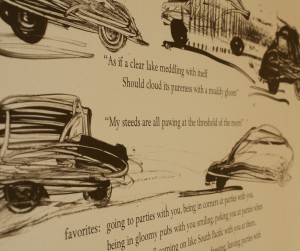 Ah, poets! That statement kind of sums up my relationship with and love for poetry. And I can’t think of any better way to be introduced to the poetry of Frank O’Hara than the Arion Press edition of Biotherm. This is a worthy addition to any library. Although probably one of the more collectible of the Arion Press titles due to the stature of the artist, don’t just collect it. Read it. We can all use more poetry in our lives.
Ah, poets! That statement kind of sums up my relationship with and love for poetry. And I can’t think of any better way to be introduced to the poetry of Frank O’Hara than the Arion Press edition of Biotherm. This is a worthy addition to any library. Although probably one of the more collectible of the Arion Press titles due to the stature of the artist, don’t just collect it. Read it. We can all use more poetry in our lives.

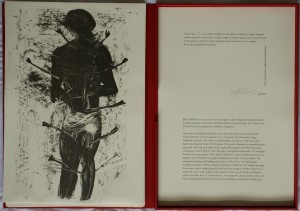 AVAILABILITY: The Arion Press Biotherm was issued in an edition of 150, with 25 of them accompanied by an extra suite of eight gravure prints selected from the images in the book. Both the stand-alone book and the book with the suite of prints are still available from the Press. If you are a subscriber, it seems they are offering a special price on the book through the end of August 2013.
AVAILABILITY: The Arion Press Biotherm was issued in an edition of 150, with 25 of them accompanied by an extra suite of eight gravure prints selected from the images in the book. Both the stand-alone book and the book with the suite of prints are still available from the Press. If you are a subscriber, it seems they are offering a special price on the book through the end of August 2013.
NOTE: The Whole Book Experience would like to thank Andrew Hoyem and the Arion Press for the generosity that made this review possible.


